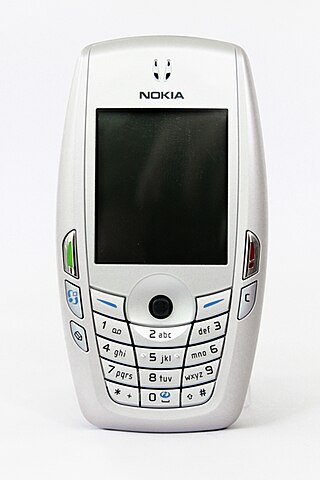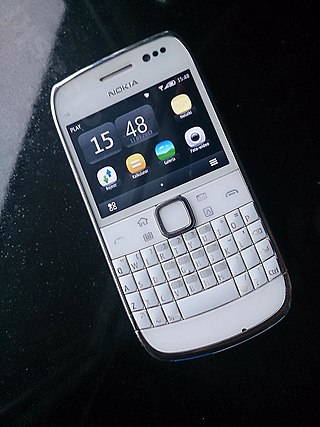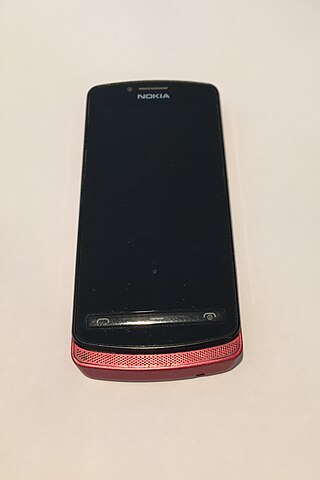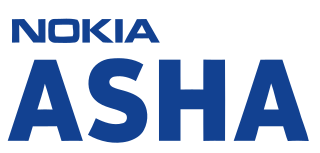
The S60 Platform is a discontinued software platform for smartphones that runs on top of the Symbian operating system. It was created by Nokia based on the 'Pearl' user interface from Symbian Ltd. It was introduced at COMDEX in November 2001 and first shipped with the Nokia 7650 smartphone. The platform has since seen 5 updated editions. Series 60 was renamed to S60 in November 2005.

The 6620 is a mobile phone created by Nokia, announced in 2005, running on Series 60 2nd Edition and the Symbian operating system. It was the first EDGE-capable phone for the Americas' market.

The Nokia N70 is a 3G mobile phone from Nokia. It was announced as part of the Nokia's new line of multimedia smartphones, the Nseries, on 27 April 2005. It started shipping in September 2005. It runs on the S60 2nd Edition, Feature Pack 3 on Symbian v8.1 operating system. It was succeeded by the Nokia N73. The N70 was popular and sold well.
Nokia Browser for Symbian was the default web browser for the S60 and Symbian mobile phone platform. The browser is based on a port of Apple Inc.'s open-source WebCore and JavaScriptCore frameworks which form the WebKit rendering engine that Apple uses in its Safari Web browser.

The Sony Ericsson Satio (U1) is a smartphone, announced by Sony Ericsson at the Mobile World Congress in Barcelona, Spain on 15 February 2009 as the Idou. It was released on 7 October 2009 in the UK in 3 colour schemes: Black, Silver and Bordeaux (Red).

The Nokia N86 8MP is a high-end mobile phone with emphasis on the camera. It was announced on 17 February 2009 and released in May 2009 as part of the Nseries. It runs on Symbian OS 9.3 and shares similar design features with the N97. Its name references the camera's megapixel count.

Samsung GT-i8910 Omnia HD is a smartphone manufactured by Samsung Electronics, first announced at MWC 2009 on February 18, 2009. The device was the first phone capable of playing and recording 720p HD video. It runs on the S60 5th Edition (Symbian^1) platform, the only Samsung device to do so.

The Nokia N8 is a touchscreen-based smartphone developed by Nokia. Announced on 27 April 2010, the Nokia N8 was the first device to run on the Symbian^3 mobile operating system and it was the company's flagship device for the year. It was released on 30 September 2010 at the Nokia Online Store before being released in markets around the world on 1 October 2010. There were two versions made, the N8 and the N8-00. The N8 was made for Vodafone and locked to its networks, and the N8-00 was made by Microsoft and open network.

The Nokia C7-00 is a smartphone from the Nokia Cseries. It was introduced on 14 September 2010 and released in Q4 2010. The C7-00 features a 3.5-inch (89 mm), 640 x 360 pixel capacitive touchscreen and features 720p video recording, and was also the world's first smartphone to have NFC capability. Nokia's mobile phone business head Anssi Vanjoki called it the "sleekest" device in the world. Unlike the Nokia N8 flagship, the C7 has physical call and hangup buttons.

The Nokia Nseries was a high-end lineup of feature phones, smartphones, and tablets marketed by Nokia Corporation from 2005 to 2011. The Nseries devices commonly supported multiple high-speed wireless technologies at the time, such as 3G, or Wireless LAN. Digital multimedia services, such as music playback, photo/video capture or viewing, gaming or internet services were the central focus of the lineup. The lineup was replaced in 2011 by the Nokia Lumia line as the company's primary smartphone lineup.

The Nokia E6-00 is a mobile phone running the Symbian^3 operating system. It supersedes the Nokia E72 as the new Symbian business mobility solution from Nokia following its announcement on 12 April 2011. It shipped with the new "Symbian Anna" version of Symbian^3, and originally retailed for 340 euros before taxes.
Nokia's strategic nomenclature can be traced back in 2005 when the Nseries line was launched, offering devices with flagship specifications and premium hardware at various price points. These devices were considered the "bread and butter" of the company and were often positioned to showcase their latest technologies. Thanks to the newfound consumer and enterprise interest in smartphones at the time, the company introduced four additional collections to diversify their product portfolio and meet demands in most market segments. These new phone series were named Eseries, targeting small business and enterprise customers; Xseries, providing consumer-grade multimedia-focused devices; Cseries, which Nokia used to target both the low-end and mid-range market segments; and Tseries, for devices exclusive to the Chinese market.
The Nokia 701 is an entry level Symbian Belle smartphone by Nokia. It was announced on 24 August 2011 and released in the third quarter of 2011. It shipped with the "Belle" version of Symbian^3. It has a 3.5" IPS LCD display with 640 x 360 pixels. The brightness of the display is 1000 nits and uses Corning Gorilla Glass. Its design is very much based on that of the Nokia C7. A Nokia Belle update increased the processor speed of the Nokia 701 from 1.0 GHz to 1.3 GHz.

The Nokia 700 is an ultra slim Symbian Belle smartphone by Nokia, running Nokia Belle operating system. It was announced on 24 August 2011 and released in September 2011. Nokia claimed it was its most eco-friendly smartphone.

The Nokia Asha 303 is a QWERTY messenger smartphone powered by Nokia's Series 40 operating system. It was announced at Nokia World 2011 in London along with three others Asha phones - the Nokia Asha 200, 201 and 300. The 303 is considered to be the flagship of the Asha family. Its main features are the QWERTY keyboard and capacitive touchscreen, the pentaband 3G radio, SIP VoIP over 3G and Wi-Fi and the ability to play Angry Birds which were all never seen before on a Series 40 phone. Nokia Asha 303 is available in a number of languages depending on which territory it is marketed for. Models sold in South Asia support at least eight languages: English, Hindi, Gujarati, Marathi, Tamil, Kannada, Telugu and Malayalam.

The Sony Xperia S is an Android smartphone from Sony launched at the 2012 Consumer Electronics Show. It was first released in February 2012 as the Sony Ericsson Xperia NX in Japan, while the Sony Xperia S was released in March 2012 as a restyled version of the Sony Ericsson Xperia NX in more than 160 countries. It is the first Sony-only branded smartphone after Sony acquired Ericsson's stake in Sony Ericsson in January 2012. The Xperia S has a 4.3 in (110 mm) touch-screen with the mobile BRAVIA engine which optimizes the picture, a 1.5 GHz dual core processor, a 12.0-megapixel rear camera, HDMI-out, 1 GB of RAM, and 32 GB of internal storage.

The Nokia Asha 302 is a QWERTY messenger feature phone powered by Nokia's Series 40 operating system. It was announced at Mobile World Congress 2012 in Barcelona along with other Asha phones - the Nokia Asha 202 and 203. The 302 is considered to be among the flagship of the Asha family. Its main features are the QWERTY keyboard, the pentaband 3G radio, SIP VoIP over 3G and Wi-Fi. Its design looks a lot like the older Nokia E6 with chrome slidings, giving it a somewhat premium look. A software update adds Mail for Exchange support.

The Nokia 808 PureView is a Symbian-powered smartphone by Nokia. It was first unveiled on 27 February 2012 at the Mobile World Congress (MWC) and released in May 2012. It is the first smartphone to feature Nokia PureView Pro technology, a pixel oversampling technique that reduces an image taken at full resolution into a lower resolution picture, thus achieving higher definition and light sensitivity, and enables lossless digital zoom. It was one of the most advanced camera phones at the time of its release.

Lumia imaging apps are imaging applications by Microsoft Mobile and formerly by Nokia for Lumia devices built on the technology of Scalado. The Lumia imaging applications were notably all branded with "Nokia" in front of their names, but after Microsoft acquired Nokia's devices and services business the Nokia branding was superseded with "Lumia", and often updates included nothing but name changes, but for the Lumia Camera this included a new wide range of feature additions. Most of the imaging applications are developed by the Microsoft Lund division. As part of the release of Windows 10 Mobile and the integration of Lumia imaging features into the Windows Camera and Microsoft Photos applications some of these applications stopped working in October 2015.
The Nokia 600 was an announced but unreleased touchscreen-based smartphone developed by Nokia. It was announced in August 2011 as one of three launch devices for the Symbian Belle operating system. The Nokia 600 was designed as a music-centric phone and would have been equipped with a 106-phon loudspeaker, which Nokia claimed was the loudest it had ever installed in a product.















